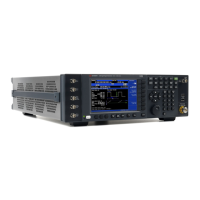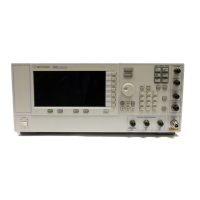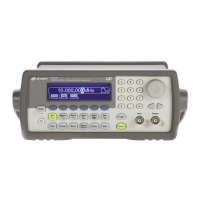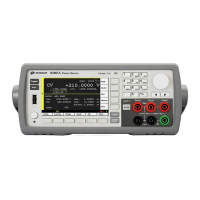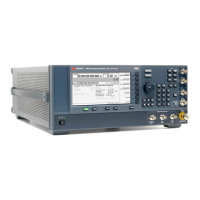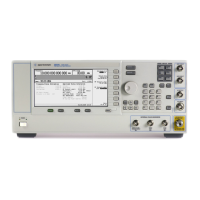What to do if Keysight Technologies N5173B EXG does not respond?
- MMartha ConwayAug 19, 2025
If the Keysight Technologies Portable Generator does not respond, it might be in remote mode. Press the Local Cancel/(Esc) button to exit remote mode.

What to do if Keysight Technologies N5173B EXG does not respond?
If the Keysight Technologies Portable Generator does not respond, it might be in remote mode. Press the Local Cancel/(Esc) button to exit remote mode.
How to fix no RF output on Keysight Technologies N5173B EXG Portable Generator?
If there's no RF output from your Keysight Technologies Portable Generator, and the RF ON/OFF LED is off, press the RF On/Off button to activate the output. Also, ensure the amplitude is within the generator's specified range and that marker polarity and routing settings are correct if a waveform is playing.
How to troubleshoot low RF output power on Keysight Technologies Portable Generator?
If the RF output power is too low on your Keysight Technologies Portable Generator and the AMPLITUDE area of the display shows the OFFS indicator, press Amptd > More 1 of 2 > Amptd Offset > 0 > dB. If the AMPLITUDE area shows the REF indicator, turn off the reference mode. If pulse modulation is on, turn off the ALC, and check that pulse width is within specifications.
Why is there no modulation at the RF output of my Keysight Technologies Portable Generator?
If there is no modulation at the RF output of the Keysight Technologies Portable Generator, check the Mod On/Off LED and the Off On softkey to ensure both are on. Also, make sure that the internal I/Q modulator is on. If using an external modulation source, verify that the external source is on and operating within the signal generator’s specified limits.
How to turn off sweep on Keysight Technologies N5173B EXG?
To turn off sweep on the Keysight Technologies Portable Generator, press Sweep > Sweep > Off.
How to fix incorrect list sweep dwell time on Keysight Technologies N5173B EXG?
To correct an incorrect list sweep dwell time on the Keysight Technologies Portable Generator, edit the dwell values. Also, ensure that the Dwell Type List Step softkey is set to List.
What to do if display turns black when using USB media on Keysight Technologies Portable Generator?
If the display turns black when using USB media with your Keysight Technologies Portable Generator, this might be caused by removing the USB media while the instrument is using it. Cycle the instrument power to resolve this.
Why does sweep appear stalled on my Keysight Technologies N5173B EXG?
If the sweep appears stalled on your Keysight Technologies Portable Generator, check the current status of the sweep indicated in the progress bar. If the sweep is in single mode, press the Single Sweep softkey. If there is a missing sweep trigger, set Sweep Trigger to Free Run. If there is a missing point trigger, set Point Trigger to Free Run. If the dwell time was set incorrectly, set the dwell time to one second. If there are few points in the step sweep or list sweep, ensure that you set at least two points in the step sweep or list sweep.
What to do if Keysight Technologies Portable Generator recognizes USB but does not display files?
If the Keysight Technologies Portable Generator recognizes the USB media connection but does not display files, the USB media may be incompatible. Try using a different USB media.
What to do if signal loss while working with a mixer and Keysight Technologies Portable Generator?
If you are experiencing signal loss while working with a mixer and the Keysight Technologies Portable Generator, add attenuation and increase the RF output amplitude.
| Output Impedance | 50 Ohms |
|---|---|
| Amplitude Accuracy | ±0.5 dB |
| I/Q Modulation | Yes |
| ALC | Yes |
| Modulation Types | AM, FM, Pulse, I/Q |
| Sweep Modes | Step |
| Harmonics | ≤ -30 dBc |
| Connectivity | GPIB, LAN, USB |
| Switching Speed | < 900 μs |
| Power Requirements | 100 to 240 VAC, 50/60 Hz |
| Frequency Range | 9 kHz to 40 GHz |
Provides an overview of the front panel controls and indicators of the signal generator.
Explains how to set user preferences from the Utility menu.
Details how to adjust display settings such as brightness and screen saver mode.
Explains how to set power-on behavior and restore factory or user presets.
Explains how to set preferences for operating the signal generator remotely.
Lists the primary operational modes available on the signal generator.
Describes the mode where the signal generator modulates a CW signal with an analog signal.
Describes modes using I/Q modulation for N5172B/82B RF vector models with Option 65x.
Explains how to return the signal generator to a known state using the Preset or User Preset keys.
Explains how to use the numeric keypad and arrow keys for entering data and navigating.
Details how to set the frequency and amplitude of the signal using dedicated keys and softkeys.
Describes how to configure the signal generator for swept signal outputs.
Details how to use the dual power meter display to show current frequency and power measured by power sensors.
Describes how the Power Meter Servo mode adjusts source output power for constant DUT power.
Explains how to digitally adjust RF output amplitude to compensate for external losses.
Details the internal calibration routine for baseband and RF magnitude/phase errors.
Explains how to move the ALC feedback source closer to the DUT for better power accuracy.
Provides a step-by-step guide on configuring and using pulse modulation.
Describes the Pulse Train feature for specifying up to 2047 independent pulse cycles.
Explains I/Q modulation and factors contributing to error vector magnitude.
Describes the two types of waveform files: segments and sequences.
Details how to store, load, and play waveform segments using BBG media.
Explains how to use waveform markers to mark specific points on a segment.
Describes how to configure trigger settings for controlling data transmission.
Explains I/Q modulation and compensation for I/Q signal differences.
Details how FIR filters compress I/Q waveforms and define transitions.
Enables licensing of waveforms for unlimited playback.
Explains how to use softkeys for custom modulation using ARB or Real-Time modes.
Describes built-in modulation formats and flexibility to modify digital formats.
Explains creating custom data formats using predefined modes or user-defined files.
Describes creating unframed digital modulation with user-defined data and parameters.
Describes defining, modifying, and storing multitone waveforms using the Multitone Setup editor.
Shows how to perform tasks for multitone setup, tone configuration, and generation.
Explains defining and modifying user-defined two-tone waveforms using the Two-Tone menu.
Describes the two-tone mode and lists tasks for configuring it.
Explains applying Additive White Gaussian Noise (AWGN) to a carrier in real time.
Shows how to apply bandwidth noise and configure RF output.
Explains controlling phase noise performance by frequency points and amplitude.
Explains how to open a menu to configure Real-Time Fading simulations.
Provides steps to configure a Real-Time Fading simulation.
Explains the VOR system for providing directional information for aircraft.
Details selecting VOR mode for full or partial signal output.
Explains ILS Localizer function for aircraft lateral/horizontal alignment.
Details selecting ILS Localizer mode for full or partial signal output.
Explains ILS Glide Slope function for vertical aircraft descent path alignment.
Explains ILS Marker Beacon function for alerting pilots to actions based on runway proximity.
Explains the Bit Error Rate Test (BERT) capability for digital communications equipment analysis.
Provides procedures to verify BERT operation and measurement validity.
Describes clocking for digital data, including timing information and diagrams.
Details setting parameters for the N5102A module in the output direction.
Explains setting parameters for the N5102A module in the input direction.
Provides steps to resolve signal generator lock-up issues.
Covers troubleshooting for RF output issues like no output, low power, or distortion.
Explains error message types and how to interpret them.
Provides contact information and resources for Keysight support.
Provides instructions to download the "Security Features and Document of Volatility" PDF.


